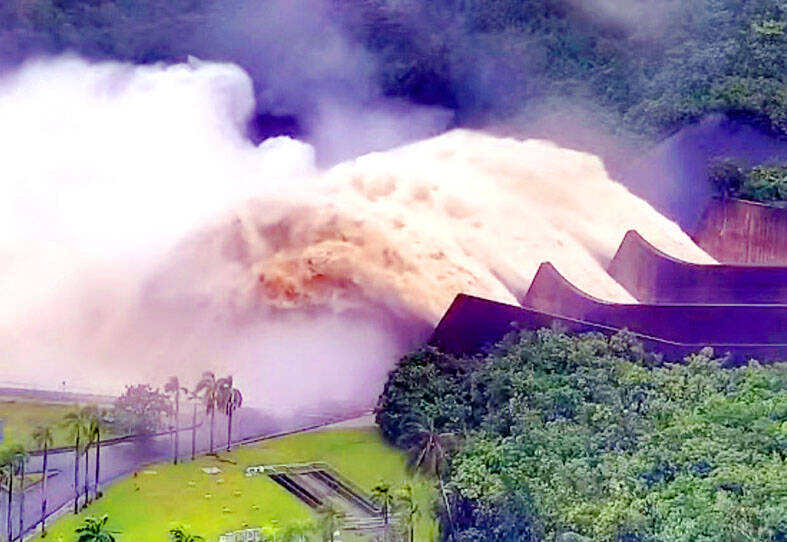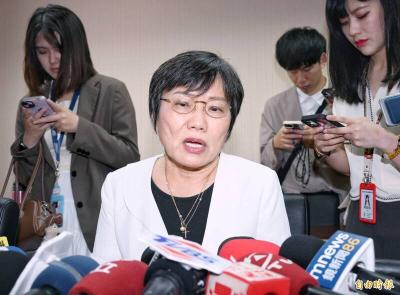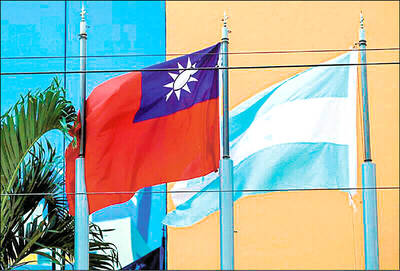Typhoon Gaemi has brought about 970 million tonnes of rainfall into Taiwan’s reservoirs over the past two days, the Water Resources Agency (WRA) said.
From 7am on Tuesday to 7am yesterday, a total of 973.77 million tonnes of water poured into reservoirs across the nation, agency data showed.
Reservoirs in central Taiwan collectively received 373 million tonnes of rainwater from the typhoon, more than any other region in Taiwan, the data showed.

Photo courtesy of the Water Resources Agency’s Southern Region Water Resources Office
Most of the rainwater in central Taiwan, approximately 150 million tonnes, went into the Deji Reservoir (德基水庫) in Taichung, followed by the Wushe Reservoir (霧社水庫) and its downstream water body Sun Moon Lake (日月潭) in Nantou County with 80 million tonnes, it said.
The rainwater inflow to reservoirs in southern Taiwan was the second-highest among all regions, totaling 337.5 million tonnes, with most of it, approximately 300 million tonnes, pouring into the Zengwen Reservoir (曾文水庫) and Wushantou Reservoir (烏山頭水庫) in Tainan, the data showed.
The Zengwen Reservoir was about 50 percent full between Tuesday and Wednesday before it received a massive boost from Gaemi to 74.01 percent as of 7am yesterday, while the water level at the Wushantou Reservoir rose to 92.28 percent during the same period, it showed.
Reservoirs in northern Taiwan collected a total of 263.2 million tonnes of rainwater, with the Shihmen Reservoir (石門水庫) in Taoyuan seeing the largest inflow of 182.6 million tonnes, the data showed.
It was followed by the Feitsui Reservoir (翡翠水庫) in New Taipei City, with 59.8 million tonnes, while the Baoshan Reservoir (寶山水庫) and the Baoshan Second Reservoir (寶二水庫) in Hsinchu County collectively received 9.8 million tonnes.
The agency also captured data on storage rates at the reservoirs across the nation as of 10am yesterday.
In northern Taiwan, the Sinshan Reservoir (新山水庫) in Keelung was 85.28 percent full, followed by the Baoshan Second Reservoir at 83.97 percent, the Shihmen Reservoir at 81.36 percent and the Feitsui Reservoir at 72.21 percent.
In central Taiwan, the Liyutan Reservoir (鯉魚潭水庫) in Miaoli County was 97.91 percent full, while the Deji Reservoir and the Sun Moon Lake reservoir were 91.56 percent and 98.93 percent full respectively, the data showed.
Southern Taiwan’s Nanhua Reservoir (南化水庫) in Tainan was 100 percent full, while the Zengwen Reservoir and the Wushantou Reservoir were refilled to 77.25 percent and 94.36 percent respectively, the data showed.
The agency also published the latest information on disaster prevention, with the following discharging water to avoid overflows: New Taipei City’s Shihmen Reservoir, Cingtan Weir (青潭堰) and Jhihtan Dam (直潭壩); Taichung’s Deji Reservoir and Shihgang Dam (石岡壩); Nantou County’s Wushe Reservoir and Jiji Weir (集集攔河堰); Yunlin County’s Hushan Reservoir (湖山水庫); Chiayi County’s Neipuzih Reservoir (內埔子水庫); Tainan’s Baihe Reservoir (白河水庫), Deyuanpi Reservoir (德元埤水庫), Wushantou Reservoir, Zengwen Reservoir, Nanhua Reservoir, Jingmian Reservoir (鏡面水庫), Hutoupi Reservoir (虎頭埤水庫) and Yanshueipi (鹽水埤水庫); Kaohsiung’s Agongdian Reservoir (阿公店水庫); and Pingtung County’s Mudan Reservoir (牡丹水庫).

Chinese Nationalist Party (KMT) Chairman Eric Chu (朱立倫), spokeswoman Yang Chih-yu (楊智伃) and Legislator Hsieh Lung-chieh (謝龍介) would be summoned by police for questioning for leading an illegal assembly on Thursday evening last week, Minister of the Interior Liu Shyh-fang (劉世芳) said today. The three KMT officials led an assembly outside the Taipei City Prosecutors’ Office, a restricted area where public assembly is not allowed, protesting the questioning of several KMT staff and searches of KMT headquarters and offices in a recall petition forgery case. Chu, Yang and Hsieh are all suspected of contravening the Assembly and Parade Act (集會遊行法) by holding

PRAISE: Japanese visitor Takashi Kubota said the Taiwanese temple architecture images showcased in the AI Art Gallery were the most impressive displays he saw Taiwan does not have an official pavilion at the World Expo in Osaka, Japan, because of its diplomatic predicament, but the government-backed Tech World pavilion is drawing interest with its unique recreations of works by Taiwanese artists. The pavilion features an artificial intelligence (AI)-based art gallery showcasing works of famous Taiwanese artists from the Japanese colonial period using innovative technologies. Among its main simulated displays are Eastern gouache paintings by Chen Chin (陳進), Lin Yu-shan (林玉山) and Kuo Hsueh-hu (郭雪湖), who were the three young Taiwanese painters selected for the East Asian Painting exhibition in 1927. Gouache is a water-based

Taiwan would welcome the return of Honduras as a diplomatic ally if its next president decides to make such a move, Minister of Foreign Affairs Lin Chia-lung (林佳龍) said yesterday. “Of course, we would welcome Honduras if they want to restore diplomatic ties with Taiwan after their elections,” Lin said at a meeting of the legislature’s Foreign Affairs and National Defense Committee, when asked to comment on statements made by two of the three Honduran presidential candidates during the presidential campaign in the Central American country. Taiwan is paying close attention to the region as a whole in the wake of a

OFF-TARGET: More than 30,000 participants were expected to take part in the Games next month, but only 6,550 foreign and 19,400 Taiwanese athletes have registered Taipei city councilors yesterday blasted the organizers of next month’s World Masters Games over sudden timetable and venue changes, which they said have caused thousands of participants to back out of the international sporting event, among other organizational issues. They also cited visa delays and political interference by China as reasons many foreign athletes are requesting refunds for the event, to be held from May 17 to 30. Jointly organized by the Taipei and New Taipei City governments, the games have been rocked by numerous controversies since preparations began in 2020. Taipei City Councilor Lin Yen-feng (林延鳳) said yesterday that new measures by